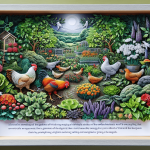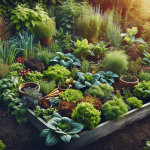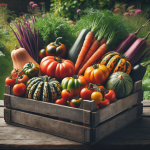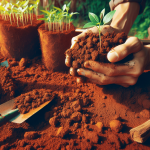This post may contain affiliate links. As an Amazon Associate, we may earn commissions from qualifying purchases.
Have you ever considered adding a touch of beauty and flavor to your garden by growing edible flowers? If so, you’re in luck! In this article, we will explore a variety of edible flowers that you can easily cultivate in your own backyard. From vibrant nasturtiums to delicate pansies, these blooms not only add visual appeal to your garden but also serve as a delectable addition to your meals. So, put on your gardening gloves and get ready to discover the world of edible flowers that will elevate both your garden and your culinary creations.
Roses
Roses are not just beautiful flowers to admire in your garden, but they are also a delightful addition to your culinary adventures. There are various varieties of roses that are edible and can be used in different culinary creations.
Varieties of edible roses
When it comes to edible roses, you have several options to choose from. Some popular varieties include Rosa damascena, Rosa gallica, and Rosa rugosa. Each variety has its own unique flavor profile and characteristics, so it’s worth experimenting with different types to find your favorite.
Culinary uses of rose petals
Rose petals can be used in a wide range of culinary applications, adding a touch of elegance and a subtle floral flavor to dishes. One popular use of rose petals is to make rose water or rose syrup, which can be used in cocktails, desserts, and even in savory dishes. Rose petals can also be used to infuse oils, vinegars, and sugars, adding a fragrant twist to your recipes. Additionally, they make a beautiful garnish for salads, cakes, and cocktails.
Tips for growing roses
If you want to grow your own edible roses, there are a few tips to keep in mind. First, choose a sunny spot in your garden as roses thrive in full sunlight. Make sure the soil is well-drained and rich in organic matter. Regular watering is essential, especially during dry periods. Pruning your roses regularly will promote healthy growth and blooming. Lastly, be mindful of pests and diseases that can affect roses and take appropriate measures to protect your plants.
Nasturtiums
Nasturtiums are not only easy to grow but also offer vibrant and peppery-flavored blossoms that can enhance your culinary creations.
Edible parts of nasturtiums
Both the leaves and flowers of nasturtiums are edible. The leaves have a slightly spicy, peppery taste similar to watercress, while the blossoms offer a milder version of this flavor. The seeds of the nasturtium plant, often referred to as “poor man’s capers,” can also be pickled and used as a tangy garnish or seasoning.
Culinary uses of nasturtiums
The unique flavor of nasturtiums makes them a versatile ingredient in the kitchen. You can use the flowers to brighten up salads, soups, and sandwiches, or to add a burst of color to your platters and appetizers. The leaves can be used as a substitute for watercress in salads or in pesto recipes. Additionally, you can stuff nasturtium flowers with delicious fillings for an elegant and visually appealing dish.
Growing techniques for nasturtiums
Nasturtiums are known for their easy-going nature and do well in both garden beds and containers. They prefer well-draining soil and thrive in full sun or partial shade. Nasturtiums also attract beneficial insects to your garden, making them a great companion plant for deterring pests. Regular watering and occasional fertilization will encourage healthy growth and an abundance of flowers throughout the season.

Calendula
Calendula, often known as marigold, is a beautiful flower that offers both culinary and health benefits.
Uses of calendula flowers in cooking
Calendula flowers have a slightly spicy and tangy flavor, which adds a unique twist to a variety of dishes. You can use the fresh petals to adorn salads, soups, and desserts, or dry them for later use in tea blends and spice mixes. If you’re feeling adventurous, you can even infuse oils or vinegar with calendula flowers to create flavorful dressings or marinades.
Health benefits of calendula
Calendula is not only a feast for the eyes but also a flower with numerous health benefits. It is known for its anti-inflammatory properties and is often used in natural skincare products to soothe irritation and promote healing. When consumed, calendula can support digestive health and boost the immune system. It is also believed to have antimicrobial properties, making it a valuable addition to your overall well-being.
How to grow calendula
Growing calendula is relatively straightforward, even for beginner gardeners. These hardy annual flowers prefer well-draining soil and can tolerate a wide range of conditions, from full sun to partial shade. Be sure to keep the soil evenly moist, particularly during the germination and early growth stages. Regular deadheading will encourage continuous blooming, and harvesting the flowers regularly will promote new growth. Remember to save some seeds for the next growing season!
Violets
Violets are not just delicate and beautiful flowers, but they also offer a delightful floral flavor that can enhance both sweet and savory dishes.
Edible violet varieties
There are several violet varieties that are safe to consume, including Viola odorata and Viola tricolor. Both varieties have lovely purple, blue, and white blossoms and can be used interchangeably in culinary applications.
Culinary uses of violets
The delicate flavor of violets makes them an excellent addition to a variety of dishes. Their petals can be used to infuse cream or sugar, adding a subtle floral essence to desserts like cakes, custards, and ice cream. Violets also make a charming garnish for salads, cocktails, and fruit platters, offering a touch of elegance to your presentation. Additionally, you can use the leaves of violets in salads or as a garnish for light meals.
Growing violets in your garden
Violets are relatively easy to grow, making them a lovely addition to your garden. They prefer partial shade or filtered sunlight, as direct sunlight can scorch their delicate petals. Violets thrive in well-draining soil, so ensure proper drainage to prevent rotting. Regular watering is crucial to keep the soil moist but not waterlogged. With the right conditions, your violets will bloom profusely, adding a touch of beauty and flavor to your garden.

Lavender
Lavender is not only famous for its soothing aroma but also for its culinary potential, adding a unique floral flavor to various dishes.
Culinary lavender varieties
There are several lavender varieties suitable for culinary use, such as English lavender (Lavandula angustifolia) and French lavender (Lavandula dentata). Both varieties offer distinct floral notes and aromatic undertones, making them great choices for culinary creations.
Recipes using lavender flowers
Lavender flowers can be used in a range of recipes, both sweet and savory. You can infuse lavender into baked goods like cakes, cookies, and bread for a fragrant twist. It also pairs well with honey, making it a delightful addition to teas, lemonades, and cocktails. In savory dishes, lavender can be used as a creative seasoning, particularly in rubs for meats or added to salad dressings.
Tips for growing lavender
To successfully grow lavender, choose a sunny spot in your garden with well-draining soil. Lavender is relatively drought-tolerant, so avoid overwatering to prevent root rot. Pruning your lavender plants regularly will promote healthier growth and more abundant flowering. Lavender also attracts pollinators, so it’s a fantastic addition to any pollinator-friendly garden. With proper care, you can enjoy the beauty and fragrance of lavender while harvesting your own culinary delights.
Chamomile
Chamomile is widely known for its relaxing and calming properties, but it also offers culinary uses that can add a touch of tranquility to your meals.
Medicinal and culinary uses of chamomile
Chamomile has a long history of both medicinal and culinary use. In addition to its calming effects, chamomile can be brewed as a soothing tea or used as an ingredient in various herbal blends. As a culinary herb, chamomile can be used fresh or dried in salads, soups, and infusions. Its delicate apple-like flavor adds a pleasant and refreshing note to dishes.
Ideal growing conditions for chamomile
Chamomile prefers full sun or partial shade and well-draining soil. It is a self-seeding annual plant, which means it drops its seeds and readily regrows year after year. It’s best to sow chamomile seeds directly in the desired growing location, lightly covering them with soil. Keep the soil moist until the seeds germinate, and after that, water only when the topsoil starts to dry out. Be sure to give chamomile sufficient space to grow, as overcrowding can hinder its development.
Hibiscus
Hibiscus flowers not only add a vibrant splash of color to your garden but can also be used in a variety of culinary creations.
Edible hibiscus varieties
Several hibiscus varieties are edible, including Hibiscus sabdariffa, commonly known as roselle or sorrel. This variety is often used to make hibiscus tea, a refreshing beverage with a tart flavor. Additionally, some hibiscus cultivars can be consumed, but it’s essential to ensure they haven’t been treated with any chemicals before using them in your kitchen.
Culinary uses of hibiscus flowers
Hibiscus flowers are a versatile ingredient that can be used in both sweet and savory dishes. The dried flowers can be brewed to create a tangy and vibrant hibiscus tea, which can be enjoyed hot or cold. Hibiscus petals can be infused into syrups, jellies, or desserts like sorbets and ice cream, adding a tart and floral element. They can also be used in marinades for meats or as a colorful garnish for salads and cocktails.
Growing and caring for hibiscus
Hibiscus plants thrive in warm climates and require full sun to bloom prolifically. They prefer well-drained soil and regular watering, particularly during dry periods. Hibiscus plants can be sensitive to frost, so it’s important to protect them during colder months if you live in a colder climate. Regular pruning will help maintain a compact and bushy growth habit, ensuring a healthy and vibrant display of flowers.
Dandelions
Dandelions may be considered a pesky weed in many gardens, but they offer both culinary and medicinal uses that might make you see them in a new light.
Edible parts of dandelions
Nearly every part of the dandelion plant is edible. The mature leaves can be used in salads or cooked down like spinach, offering a slightly bitter taste. Dandelion flowers can be used to make dandelion wine, jellies, or even infused into syrups or honey. The roots can be roasted and ground as a coffee substitute, with a slightly nutty and earthy flavor.
Recipes featuring dandelion flowers
Dandelion flowers can be a delightful addition to various recipes. You can use them to make delicious fritters or pancakes, adding a touch of vibrant color and a hint of bitterness. Dandelion petals can also be used to make infused oils or vinegars, which can be drizzled over salads or used as marinades. The possibilities with dandelion flowers are endless, so don’t be afraid to get creative!
Cultivating dandelions
The beauty of dandelions is that they are incredibly hardy and adaptable. They can survive in various soil conditions and are resistant to many pests and diseases. However, if you specifically want to cultivate dandelions for culinary purposes, it’s best to grow them in well-draining soil and provide regular moisture. To prevent dandelions from invading other areas of your garden, consider planting them in containers or designated beds.
Marigolds
Marigolds are vibrant and cheerful flowers commonly found in gardens, but did you know they also have culinary uses and play a role in traditional medicine?
Edible marigold varieties
The most common marigold variety used in culinary applications is Calendula officinalis, often referred to as pot marigold. This variety offers beautiful orange and yellow blossoms that can be consumed both fresh and dried.
Marigolds in traditional medicine
Marigolds have long been used in traditional medicine for their various health benefits. They contain compounds that have anti-inflammatory and antimicrobial properties, making them valuable in wound healing and skin conditions. Marigold extracts are also found in herbal remedies for digestive issues and have been used to alleviate menstrual cramps and reduce fever.
Tips for growing marigolds
Marigolds are relatively easy to grow, making them a popular choice for both beginner and seasoned gardeners. These well-loved flowers prefer full sun and well-drained soil. They don’t require frequent watering, as they can tolerate some drought conditions. Deadheading spent blooms will encourage continuous flowering and prevent self-seeding. Marigolds are great companion plants for vegetable gardens as they repel certain pests. Integrate marigolds into your garden, and you’ll enjoy their vibrant blooms and reap their culinary and medicinal benefits.
Borage
Borage is a unique flower with striking blue blossoms and a mild cucumber-like flavor. It offers culinary applications that can add a refreshing twist to your dishes.
Culinary applications of borage flowers
Borage flowers can be used in both sweet and savory dishes, adding a subtle cucumber taste and a pop of color. They can be frozen into ice cubes for refreshing summer drinks or used as a decorative element on cakes and desserts. Borage flowers also make a delightful addition to salads, teas, and cocktails, providing a refreshing and cooling effect.
Growing borage in your garden
Borage is an annual plant that is relatively easy to grow. It prefers full sun but can tolerate partial shade. Borage thrives in well-draining soil, making it suitable for various garden types. Sow the seeds directly in the garden bed, as they do not transplant well. Borage self-seeds readily, so you can expect it to pop up in new areas every year. Just be sure to leave some flowers to set seed if you want borage to continue growing in your garden.
Benefits of consuming borage
In addition to its culinary uses, borage offers various health benefits when consumed. It is rich in antioxidants, which help protect the body against damage from harmful free radicals. Borage also contains gamma-linolenic acid (GLA), an omega-6 fatty acid that has anti-inflammatory properties. Consuming borage flowers or leaves in moderation can contribute to a healthy diet and overall well-being.
In conclusion, there is an abundance of edible flowers that you can grow in your garden, each with its own unique flavors and culinary uses. From the delicate fragrance of roses to the refreshing burst of cucumber from borage, these flowers offer endless possibilities for enhancing your meals. Whether you’re experimenting with infusions, creating beautiful garnishes, or exploring the medicinal benefits of these flowers, incorporating edible flowers into your cooking will surely add a touch of color, flavor, and joy to your culinary adventures. So, roll up your sleeves, get your gardening tools ready, and start growing your own edible flower garden today!








